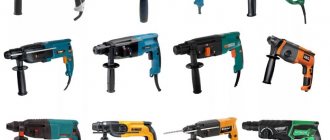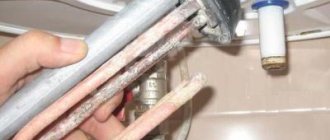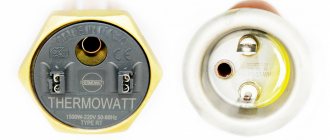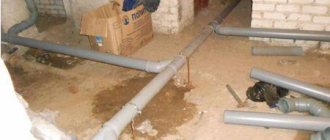To heat private residential buildings, electrical equipment is used that is connected to a household or industrial AC network. A detailed analysis of the operating principle and technical parameters makes it possible to find out which boiler is better - a heating element or an electrode one. The reliability of the heating circuit installed in the building depends on the correct choice of heating device.
How to properly replace the heating element in a boiler
A part is replaced if it breaks due to lack of regular cleaning of the boiler
The need to replace the heating element arises when it malfunctions. When it stops heating the water, the electrical protection device is triggered. The average service life is 4 years. Then it fails due to increased water hardness. This event can be delayed if you perform annual boiler maintenance: clean the heating element and magnesium anode from scale. This operation will increase the duration of operation and improve the quality of water and the rate of its heating. Before purchasing a new element, you should check the condition of the old heating element using a test lamp or multimeter. In the first case, a simple electrical circuit is assembled, including a lamp and a heater. If the light is on, it is not the problem. In the second case, the resistance is measured with a special device. A zero value indicates a heater malfunction.
The designs of different boiler models have minor differences, but the principle of replacing heating elements in a water heater is the same for all types of devices.
To begin with, turn off the water supply and drain the remaining liquid from the boiler. The water heater must be de-energized by unplugging the plug from the socket. At the bottom of the boiler there is a cover that is attached with screws. You need to unscrew them with a screwdriver and the cover will come off. For safety reasons, before you start replacing the heating element in the boiler, you need to check the presence of voltage at the terminals, for example, using an indicator screwdriver. Then disconnect the wires and unscrew the nuts holding the heater in place. Replace the heating element on the water heater, first checking that the contacts are dry. If an anode is installed in the boiler, replace it as well. Check the seal for leaks and screw the lid into place. After these manipulations, you need to fill the boiler with cold water and bleed the air from it by opening the hot water tap. Only now can you turn it on to the network.
Connections and flanges
The second drawback in comparison is the large number of sealing connections (heating elements, flanges) and their complete absence in an induction boiler. Here these advantages and disadvantages can even be swapped.
After all, if the heating element does fail, you can easily replace it. Or simply exclude it from the circuit for a short time, set the jumpers differently and continue working.
But if the coil burns out (due to an interturn short circuit), how much will the repair cost you? And will you be able to keep warm with such a breakdown?
Criterias of choice
When choosing a heating element for a boiler, you need to build on the characteristics of the previously installed element.
Types of devices
The material of the tank and heating element must match, so stainless steel parts are often purchased
. In addition to the type of heating element in contact with liquid, you need to take into account a lot of other parameters:
Mounting method: nut or flange. The latter can be cast or stamped. Flange mounting is typical for open-type heating elements; Possibility of installing an anode - this element is designed to protect metal surfaces from corrosion and scale, thereby increasing the overall service life of the boiler. The anode gradually “melts”, so a new one must be installed periodically. If there is a hole for the anode in the base of the heating element, then a new heater with the same hole is needed. The shape depends on the type of storage container. The heating element can be straight or bent. A heating element similar to the previously installed one is selected, taking into account not only the shape, but also the size, as well as the bending angle. Manufacturing material - the outer surface of the heating element can be made of copper or stainless steel
It is important that the material of the tank and heating element match, otherwise, due to the difference in potential, the service life of the heating element and the tank itself will be shortened. A closed-type copper heater can be located inside an enameled steel flask, in which case you don’t have to worry about creating a galvanic couple.
Features and amount of heated liquid
Heating element with magnesium anode for hard water
If the water is hard, you need a heating element under the anode, which will partially eliminate the problem of scale and extend the life of the boiler. The power must correspond to the volume of the heated liquid. It is recommended to purchase a part of the same power as the failed one. The heater parameters are indicated in the technical data sheet of the device.
terms of Use
The power must match the wiring capabilities. But this applies more to the choice of a boiler rather than a heating element, since the old element is replaced with a new one of similar power. The power of the boiler as a whole also affects the heating rate of a given volume of water. If the heating element is low-power, for example 1000 W, and the capacity is 80 or even 100 liters, it will take a very long time for the water to heat up to the maximum temperature, several hours, so you need to turn on the boiler in advance. This power is optimal for small boilers, up to a maximum of 50 liters.
If you plan to consume a lot of hot water, it is recommended to buy a model with two heating elements. They heat the water faster. In economical mode, one element will work, and the second will be connected thanks to the thermostat when it is necessary to heat a new portion of cold water.
Filling the radiator with water
How much liquid is needed for such a heater?
Mistake #10
When filling a radiator, you don’t want it to end up 100% full of water.
Filling occurs through the hole of the already installed passage plug. First, fill the radiator up to the neck.
Then you set it perfectly level and unscrew the plug or the Mayevsky valve (not the fitting itself), draining the excess volume.
If the battery is already hanging on the wall, you can use a small watering can with a tube or hose stretched over the spout.
Mistake #11
Try not to use regular tap water.
The water should be soft. A hard one will kill your heater very quickly.
Distilled or rainwater is best (it's free). As a last resort, water from an osmosis filter.
Just enough water is needed so that it stops flowing through the hole under the Mayevsky tap. That is, the liquid level should end exactly at the level of the small hole in the passage fitting.
When pouring water along the edge of the hole, you will automatically get the desired level of the liquid column, which will ensure uniform, proper circulation.
One section of a cast iron battery (MS 140-500) holds about 1.5 liters of water. In aluminum (height 500mm) - no more than 0.35-0.45 liters. The required volume is calculated by the number of ribs.
Categories of heating elements by type of contact with liquid
In a dry heating element there is no contact with water, which extends the service life of the part
A nichrome spiral is hermetically sealed inside the heating element for heating water, and the space between it and the outer walls is filled with quartz sand. The outer tube can be made of copper, carbon steel or stainless steel.
Open heating elements come into direct contact with water. Their main advantage is the high speed of heating the liquid and low cost, but there are also significant disadvantages:
- limited service life;
- rapid formation of limescale;
- high electricity consumption;
- insecurity.
Closed ones do not come into contact with water. The heating element is protected by a durable bulb. Its advantages:
- the likelihood of an electrical short circuit is reduced;
- easy to repair and maintain;
- serve for a long time - three times longer than open heating elements;
- consume significantly less electricity than open-type heating elements.
There are two important disadvantages: high price and slow water heating.
Metal materials used for heating
- Nichrome: the vast majority consists of nichrome 79/21 (79% nickel, 21% chromium), for example Fastov heating elements, are produced in the form of wire, tape or strip. It is a first-class material because it has a relatively high resistance and forms a layer of chromium oxide when heated for the first time. The material under this layer does not oxidize and is protected from destruction and burnout.
- Metal Resistance: The metal resistance of heating elements can be in the form of wire or tape, straight or spiral. They are used in general heating devices such as heating elements, toasters, hair dryers, furnaces for industrial heating, floor heating, roof heating (to prevent icicles from forming), trail heating (to melt snow and ice), dryers, etc.
The most common materials used for the manufacture of heating elements in Fastov at Elektronagrevatel ODO:
- Nichrome - wire and strips;
- Cupronickel (copper-nickel) - alloys for heating at low temperatures.
How to connect a heating element with a thermostat
Now you know how and by what parameters heaters are selected. But how is the connection made? In order to connect a heating element with a thermostat, you must select a wire with reliable insulation
We also pay attention to the cross-section - it must be such that the wire can provide adequate power to the heater and not melt. For example, for a 3 kW heater, the wire cross-section must be at least 2.5 mm. We recommend choosing cables with copper conductors for connection
Do not forget to pay attention to the presence of an RCD - it will instantly turn off the power in the event of an unexpected failure of the heating element or a short circuit. The RCD must be installed as close as possible to the heater itself
You should also ensure a reliable connection of the conductors with the contacts of the heating element (without “snot” and flimsy contacts that can spark).
Temperature regulators are used quite widely for domestic purposes, and they regulate the temperature literally everywhere: from a common soldering iron to the microclimate in the house.
Summarizing
Electrode installations have increased reliability and safety in the event of a liquid supply interruption, but the equipment requires the preparation of a special solution. When the device operates, stray currents arise that destroy metal parts of the structure.
Equipment production is carried out by small companies, while electrode boilers do not provide energy savings. Therefore, it is recommended to use standard heating devices with heating elements produced by large companies in homes.
Advantages of dry heating elements
If you compare a dry design with a submersible one, the first one will have a lot of advantages:
- no scale;
- compact dimensions;
- ease of maintenance;
- excellent performance;
- long service life;
- no air pockets.
The main problem with all water heaters is scale.
The reason for the formation of this layer is poor quality water and the fact that the surface of the heater comes into contact with the liquid. Harder water causes scale to form much faster, and the lime layer is thicker and denser. Because of this phenomenon, the heating rate is significantly reduced, and the service life of even the most expensive water heater is noticeably reduced. The dry structure is reliably protected from such troubles, since there is no contact with water, which means scale cannot form.
Since most developers allocate catastrophically little space to the toilet and bathroom, the second important criterion for choosing a boiler is its size. The dry heating element has quite miniature dimensions in comparison with its “wet” relative. Since the size of the water heater itself is significantly reduced, it is not unreasonable for the manufacturer to install two or even three heating elements, which allows the consumer, if desired, to heat the water in just a few minutes. Moreover, the consumer is not afraid of interruptions in the operation of one of the heaters, since he can always use the remaining ones.
High performance and easy maintenance
Since scale does not form on a dry element, the speed of obtaining hot water increases significantly.
The water heater does not spend a large amount of energy to fulfill its direct responsibility, which puts a dry heating element a step higher in comparison with a wet one. Another important feature of the tubular element is the ease of repair. Despite the fact that such an element is durable, it can still fail. In order to repair the device, you do not need to completely dismantle the tank. You just need to unscrew the protection and remove the element. After inspection and repair, the heating element is put back. According to a similar scheme, the tank is cleaned of scale every six months. In this case, the heating element is not affected, and only the inner wall of the tank is cleaned.
Water heater durability
Due to the fact that the heating element itself does not come into contact with water and is not covered with scale, its service life can last for 5-6 years, while a submersible heating element will have to be changed every 2 years.
With current prices for components, this advantage allows you to save a lot of money, even though a water heater with a dry heating element costs an order of magnitude more. Manufacturers also made sure that the boiler does not turn on if there is no water in it at the moment. Dry start protection is installed in absolutely all water heaters with a dry element. This function allows the unit not to burn out and last longer.
If you still need to repair the element, the variability of such a water heater will be a pleasant surprise. Tubular heating elements differ little from each other, so finding the right part will not be difficult.
Composite heating elements
Tubular heating elements
Tubular elements typically consist of a thin nichrome coil or heat-resistant alloy wire that is contained in a metal tube (stainless alloys such as Incoloy or copper) and powder insulated (magnesium oxide).
To maintain constant humidity in the hygroscopic insulator, the ends are equipped with an insulating material, such as ceramic or silicone rubber or a combination of both. The pipe is pulled through a die to compress the powder and maximize heat transfer. They can be straight (as in a toaster), or curved to enclose the heated space (for example, in electric ovens and coffee makers).
Polymer heating elements
Resistance heaters can be made from conductive rubber PTC materials, where the resistance decreases as the temperature increases. Such a heater will generate high power to heat water when it is cold and constantly maintain the desired temperature.
Due to the decreasing specific resistance of the heater, such a heating element will never be able to produce more heat than necessary. When heated to a certain temperature, PTC materials act as an electrical insulator and do not allow current to pass through, after which they naturally stop heating. The temperature can be selected during the manufacturing process, with typical temperatures being between 0 and 80 °C (32 and 176 °F).
Thus, heating elements made of polymer materials are self-regulating. This means that it independently maintains a constant temperature without the need for electronic regulation. Self-limitation means that the heater is not able to exceed a certain temperature and does not require the use of overheating protection.
Purpose of heating elements
Why do we need heating elements with thermostats? Based on them, autonomous heating systems are designed, boilers and instantaneous water heaters are created.
For example, heating elements are mounted directly into batteries, resulting in sections that can operate independently, without a heating boiler. Some models are focused on creating anti-freeze systems - they maintain a low positive temperature, preventing freezing and subsequent rupture of pipes and batteries.
This battery has a built-in heating element with a thermostat, with its help the house is heated.
Storage and instantaneous water heaters are created on the basis of heating elements. Purchasing a boiler is not affordable for every person, so many assemble them themselves using separate components. By installing a heating element with a thermostat into a suitable container, we will get an excellent storage-type water heater - the consumer will only have to equip it with good thermal insulation and connect it to the water supply.
Bulk-type storage water heaters are also being created on the basis of heating elements. In fact, it is a container of water that is filled manually. Heating elements are also built into summer shower tanks, ensuring water heating to a given temperature in bad weather.
Heating elements for heating water with a thermostat are necessary not only for creating water heating equipment, but also for repairing it - if the heater fails, we buy a new one and replace it. But before that, you need to understand the issues of choice.
conclusions
- It is generally accepted that heating a house with electricity is not cheap. This is certainly true if we mean only payment according to tariffs. However, to the price of heating you need to add the cost of the equipment, as well as the costs of its maintenance and repair.
- If you compare bills for electricity, firewood, coal, pipes, boilers and other equipment, you can come to the conclusion that private heating with electricity is cheaper than solid-state boilers, stoves and other systems alternative to gas heating.
- In addition to money, there is another argument in favor of electric heating - it saves time: turn it on, leave and forget. The only downside is a sudden power outage.
Below, watch a video about how we managed to create cheap heating with electricity for a large private house.
Popular manufacturers
Each boiler manufacturer produces heating elements only for its own equipment.
You should choose heating elements from a trusted manufacturer. This is not an element you need to skimp on. The best companies include:
- Thermex. It has been producing boilers for almost 50 years. This manufacturer produces heating elements from copper and stainless steel. They are reliably protected and therefore have a long service life. In the market, Termex has established itself as a manufacturer of boilers of the largest volume, so you can find powerful electric heaters in its assortment.
- Ariston. The heating elements from the Italian manufacturer are made of an alloy containing copper and equipped with a chromium-nickel tube. The flange is made of brass, which increases heat transfer. They are well protected from scale and easy to install. And at the same time they are relatively inexpensive. Ariston offers water heating heating elements with threads and a thermostat from 1.2 to 4.5 kW.
- Electrolux. You can choose a heating element from this manufacturer for almost any heater model. At the same time, they are guaranteed to last a long time, since they are especially resistant to scale and are not demanding on water quality. A water heater with a heating element from Electrolux does not require frequent maintenance. Some devices from this manufacturer are equipped with two closed heating elements, so it is possible to increase the heating rate of the liquid.
- Timberk. Another manufacturer that offers its products at an affordable price. The assortment includes heating elements designed for boilers with 80 or more liters of water. They are well protected from corrosion and other destructive factors.
- The company Atlantic is also known. It produces a wide range of high-quality and reliable heating elements for boilers, including copper water heating elements, dry soapstone and others, suitable for vertical and horizontal installation.
Each manufacturer produces electric heaters designed for installation in boilers of their own production. However, you can also find universal heating elements. They are less popular due to their dubious quality, but their use is possible.
Additional functions of electric heaters
Above we discussed the simplest designs of devices that do not have any built-in adjustment mechanisms.
The thermoregulation unit can have mechanical or electronic automation. The latter is more accurate, but is demanding on the parameters of the home electrical network
But electric water heaters can be equipped with simple automation that provides the device with additional functions.
These include:
- Thermoregulation . Heating elements with a built-in thermostat for heating have a temperature sensor that is triggered when the working environment is heated to a certain level. The electric heater is adjusted from the outside of the flange.
- Antifreeze . This function is provided by a simplified thermostat, which operates only when the temperature drops to 0-2°C. It prevents water from freezing in heating pipes, consuming a minimum of electricity.
- Turbo heating , which provides forced heating of the working environment during the initial start-up of equipment. It must be remembered that the electrical wiring of the room must withstand a short-term increase in power.
There are not many devices that support additional functions, because the operation of heating devices as a whole is often regulated using a separate automation unit.
Types of heating elements according to operating principle
The features of open and closed heating elements are clear from the name. The former are not protected from water, the latter are covered with a flask. They are also called wet and dry. The principle of their operation should be considered in more detail.
Wet
Wet-type heating elements are tubular, they are in direct contact with water and heat the water with their surface. Their service life depends on the quality of the water, its hardness, and the percentage of salts. Due to the influence of these factors, the metal corrodes, and limescale forms on the surface. By installing a magnesium anode, the process can be slowed down, since the element attracts salts. Vitreous enamel is also used to protect water heating tubes.
Dry
A dry heating element is a heater that is placed in a flask filled with a second layer of ceramic backfill (the first layer fills the space between the nichrome spiral and the tube in which it is placed). The waterproof shell is made of magnesium silicate or steatite. Soapstone heats up quickly and cools down slowly, has increased strength and high heat resistance. The advantages of using a dry heating element in a water heater outweigh the disadvantages, and in particular, to replace such a heating element, you do not need to drain the water from the boiler.
Mayevsky tap or valve?
You can get by with a Mayevsky crane, but then you will need one more protection.
An external emergency thermostat with an operating temperature in the region of 80-90C is mounted on the first section of the battery (counting from the heating element). Moreover, it is connected to the power supply of the heating element itself.
When the heating element’s original thermostat does not work and the water begins to approach the boiling point, the emergency temperature sensor operates. It interrupts the voltage supply and saves the battery from explosion.
Which is better - an emergency valve or an external thermostat? It is still preferable to have a valve.
The design is simpler and more reliable.
Connection methods
It should be noted that heating elements for boilers can be mounted into the device either one at a time or several at once.
Parallel connection
This connection option must meet certain requirements.
The basic rules are as follows:
- The voltage both in the electrical network and in each individual element must be the same.
- To determine the total power of the boiler, you need to sum up the powers of all installed elements.
- If for a certain reason one of the heating elements breaks, the circuit will continue to operate. In this case, the only thing that needs to be done is to replace the broken element.
Serial connection
The second option is a serial connection. In this case, it is necessary to follow the operating principles:
- If one of the heating elements breaks, the operation of the entire network will be interrupted.
- To find out the total resistance, you need to sum up all the resistances in the network.
- The total voltage cannot be greater than the total voltage of all heating elements.
Combined method
Taking into account this diagram, different connection options must be used in several sections of the electrical circuit. Quite often, a combined method is advisable if it is impossible to purchase heating elements of the required power. In this case, available heating elements are installed, and the required value is achieved using various connection methods.
Safety valve installation
That is why the design should provide protection in the form of an emergency valve.
Mistake #12
Do not install a standard explosion valve, like on boilers.
You need a device with a response pressure of 3 bar.
The operating pressure of a standard cast iron battery in a central heating system is about 9 atmospheres (1 bar = 1 atm). In our closed battery in normal heating mode it will be no more than 1.0-1.5 bar.
To measure pressure, you can install a small pressure gauge instead of one of the plugs.
You will be able to monitor the operation of your heating system in real time.
Mistake #13
Do not point the “explosive” valve towards the wall where the socket and plug are located.
To prevent liquid from periodically dripping from it, the safety valve can be turned upside down. In this case, the release of gases rather than water will predominate.
Selecting a heating element
When choosing a heating element, you need to pay attention to some details. Only in this case can you count on a successful purchase, high-quality heating, long service life and compatibility of the selected model with a water heating tank, boiler or radiator
Shape and size
There are dozens of heating element models available for buyers to choose from. They have different shapes - straight, round, figure-eight or ear-shaped, double, triple and many others. When purchasing, you should focus on the use of the heater. For installation in sections of heating radiators, narrow and straight models are used, since there is quite little space inside
When assembling a storage water heater, you should pay attention to the volume and shape of the tank, and based on this, choose a suitable heating element. In principle, almost any model will fit here
If you need to replace a heating element in an existing water heater, you need to purchase an identical model - only in this case can you count on the fact that it will fit into the tank itself.
Power
If not everything, then a lot depends on power. For example, this could be the heating rate. If you are assembling a small-volume water heater, the recommended power will be 1.5 kW. The same heating element will be able to heat disproportionately large volumes, but it will do this for a very long time - with a power of 2 kW, heating 100-150 liters of water can take 3.5 - 4 hours (not to a boil, but on average by 40 degrees).
If you equip a water heater or water tank with a powerful 5-7 kW heating element, the water will heat up very quickly. But another problem will arise - the house electrical network will not withstand it. When the power of the connected equipment is above 2 kW, it is necessary to lay a separate line from the electrical panel.
Protection against corrosion and scale
When choosing heating elements for heating water with a thermostat, we recommend paying attention to modern models equipped with scale protection. Recently, models with enamel coating have begun to appear on the market.
It is this that protects the heaters from salt deposits. The warranty on such heating elements is 15 years. If you don’t find similar models in the store, then we recommend purchasing stainless steel electric heaters - they are more durable and reliable.
Heat dissipation
According to factory parameters, such batteries (with a height or center distance of 500 mm), when integrated into a full-fledged hydraulic heating system, are capable of dissipating slightly less than 200 W of thermal power per section (180 W aluminum, 140 W cast iron).
However, in our case, do not expect such numbers. Firstly, the heat output of 180/140W is provided only by a new battery. And for such a heater, as a rule, used options are used.
Buying a new one for such a homemade product is not economically feasible.
Secondly, such work is only possible in the 90C-supply, 70C-return mode. In this assembly we use heating elements with an optimal operating temperature of 60-65C.
When it’s cold outside down to -25C, you can turn it up to +70-75C. The maximum possible temperature is + 80C.
Therefore, you will never heat such a battery to 90C in NORMAL operation. In principle, this is not necessary, since it entails the risk of a sharp increase in pressure.
Operation of electric boilers: fourth year
There are no significant changes in the economy of our enterprise. We are already accustomed to the fact that during the season we need to regularly monitor the operation of the heating element boiler. They even installed a GSM control system on it. But we will not take these costs into account: after all, we agreed that we are evaluating a “clean pot” without piping.
Thermal productivity continues to decline, by 20%. It is due to the fact that the old heating elements are working. Their reliability is deceptive: they work, but they don’t provide power. As they say, it’s a pity to throw it away, but it’s more expensive to keep it.
By the end of the 4th year of operation, almost all heating elements that were once new had to be replaced. Still, some of them honestly worked 10 thousand hours – an excellent indicator.
With an induction heater you can only wipe off dust - absolutely nothing else.
| Fourth year | Induction heater | New heating element |
| Heating period, days. | 200 | 200 |
| Continuous operation time, hour/day. | 10 | 15,18 |
| Energy tariff | 2,8 | 2,8 |
| Electricity costs, rub/season | 50×200×10×2,8=280 000 | 50×200×15,18×2,8=425 040 |
| Risk of accident | 0 | 50 |
| Costs of consumables, rub. | 0 | 10,000 (replacement of 5 heating elements) |
| Labor costs for operation* | 0 | 950 |
| Current expenses for the period | 280 000 | 425 040+10 000+950=435 990 |
| Total expenses on a cumulative basis | 985 000+280 000=1 265 000 | 994 960+435 990=1 430 950 |
By the end of the fourth year of operation, the induction heater is already an absolutely confident leader in our competition, actually saving the enterprise money, not only monetary, but also time and human.
Only one thing can be said about the tensile boiler: if this continues, the electrician will only deal with it and will have to hire another one to work with the rest of the equipment...
Decrease in electric boiler efficiency
Another argument for comparison is that an induction boiler does not lose its original power during operation. But with heating element, due to scale formation, this happens as a matter of course.
Even sometimes calculations are given, according to which, within just one year, the power of a heating element decreases by 15-20%. This means that its efficiency also decreases.
Let's look at this in more detail.
Almost any electric boiler has an efficiency exceeding 98%. And even boilers operating at ultra-high frequency currents from 25 kHz and above, what can they change for you? Add an extra one and a half percent, but at the same time jump the price by 100%?!
As for deposits on the heating element element, they are indeed present.
In water supply systems in direct heating boilers, a certain “scale” is deposited on the working element. It actually gradually prevents the water from heating up quickly.
What happens where there is no constant supply of impurities? A small layer of deposits may settle on the heating element, however:
- this layer is not thick enough
- it does not in any way interfere with heat transfer
For example, let’s assume that on a clean surface of the heating element, heat transfer occurs at t=60 degrees. As soon as this surface becomes contaminated with deposits, heat exchange will not disappear anywhere, but will begin to occur at high degrees, say 75-80C.
And accordingly, the boiler in no way loses its original efficiency.
That is, in fact, both on a clean heating element and on a dirty one, the same amount of energy is transferred, only at different temperatures.











